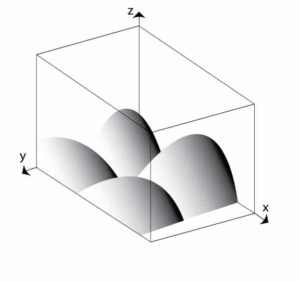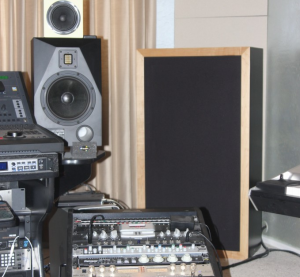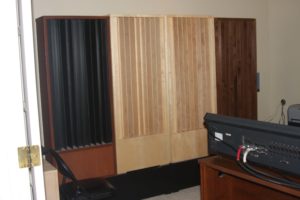If you divide the room into two frequency ranges for our room speaker system, you can determine which of the total room sound you hear is contributed to the room and which part of the total room sound is contributed by the speakers. If you take 500 Hz. as the dividing frequency, you quickly realize that any frequency greater than 500 cycles causes acoustical issues which are speaker generated. Any acoustic distortion below 500 Hz. is caused by the room and its particular physical dimensions.
On Axis / Off Axis Response
To give you an idea of how sensitive proper speaker and room interactions must be in your system, we can look at the polar and off polar response patterns of speakers. All manufacturers produce this measurement and it is relatively easy to look at both on axis and off axis response patterns. You are looking for a similar pattern to the off and on axis response curve, not an identical measurement because by definition they can not be identical, but a general response pattern shape. Any deviation in general shape of these patterns will produce an audible speaker distortion into our room.
Room Distortions
There are four main room contributing acoustical distortions that you must deal with from your room. The first, has to do with the speaker itself and is labeled speaker boundary interference effect or SBIE. It is the acoustic distortion that results from the speakers physical proximity to surrounding room walls. It is that area between the speaker and the closest room boundary surface, the next closest room boundary surface and so on. It can be reflection based distortion or room pressure increases and decreases in that physical space between speaker and wall that contribute to sounds in your system.
Room Modes
Room modes are always a topic for discussion when it comes to small room sizes and volumes. These lower frequency waves are longer in length than the room dimension that you try to place them in through playing your music and they express their discontent of the fit by moving air in a particular room area. This air movement produces pressure build up areas. Usually the area is between two surfaces that have a physical separation distance that the particular frequency with its corresponding wavelength does not like. These pressure areas produce all kinds of acoustical room distortions that plage our room speaker systems.
Pressure Areas
If the pressure area created by a room mode is pronounced, it can actually smother or hide certain frequencies, especially lower ones. It can act like a black hole and suck all that frequency specific energy up into it. You can boost for it with EQ, but you will probably blow up a low frequency driver or sub woofer in the process. Once energy that the room mode likes enters it, like the black hole, it is gone forever. The opposite can also occur with certain frequencies being more pronounced. Excessive pressure areas can exaggerate certain frequencies. This is the name for the phenomenon labeled “bass boom” and we have all heard it in our room speaker systems.
Comb Filtering
Comb filtering is a middle to higher frequency situation. A comb filter named for its appearance on a measurement graph, teeth or reflections are grouped together to produce an image of the teeth of a comb. This series of closely grouped reflections, performs a similar function as a room mode in that it can hide or mask other frequencies that fall below the frequency range of the comb filter. Comb filters can wreck havoc on our middle range frequencies where our vocals lie. Without vocal timbre and texture which can be obscured by a comb filter, we lose emotion connectivity to our vocals and thus our music.
Room Diffusion
Poor room diffusion is another acoustical room distortion that is quite prevalent in today’s musical oriented, room usage. Our acoustical design goal is to make the room vanish acoustically and not produce any sound of its own. You do not want room modes or excessive surface boundary reflections at your listening or monitoring positions. You do not want any frequencies smothered or exaggerated in your mixes or playback sources. Room diffusion can reduce the negative impact of reflections. Diffusion can acoustically make some room surfaces disappear and allow for better sound blending at the cut off frequency of 500 Hz. in our room speaker system.
The Speaker And The Room
The speaker and room are the two biggest acoustical players both competing for our attention in the room itself. Today’s speakers can produce audible distortions when the off axis and on axis response of the speaker is of a dissimilar pattern. Speakers are that sensitive and care must be taken in selecting a speaker that meets that on axis and off axis dispersing criteria. Failure to match this one simple area can cause distortions in our music. Room modes, comb filters, SBEI, and poor room diffusion are the room’s contributions to our final sonic equation that we hear. We must mange all of them and reduce their rates and levels.








